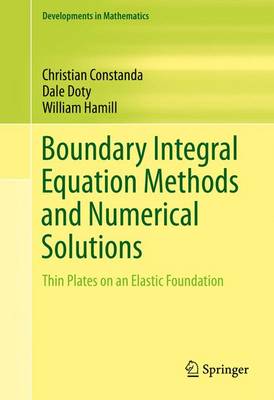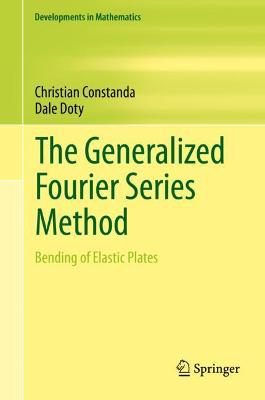Developments in Mathematics
2 primary works
Book 35
Boundary Integral Equation Methods and Numerical Solutions
by Christian Constanda, Dale Doty, and William Hamill
This book presents and explains a general, efficient, and elegant method for solving the Dirichlet, Neumann, and Robin boundary value problems for the extensional deformation of a thin plate on an elastic foundation. The solutions of these problems are obtained both analytically-by means of direct and indirect boundary integral equation methods (BIEMs)-and numerically, through the application of a boundary element technique. The text discusses the methodology for constructing a BIEM, deriving all the attending mathematical properties with full rigor. The model investigated in the book can serve as a template for the study of any linear elliptic two-dimensional problem with constant coefficients. The representation of the solution in terms of single-layer and double-layer potentials is pivotal in the development of a BIEM, which, in turn, forms the basis for the second part of the book, where approximate solutions are computed with a high degree of accuracy.
The book is intended for graduate students and researchers in the fields of boundary integral equation methods, computational mechanics and, more generally, scientists working in the areas of applied mathematics and engineering. Given its detailed presentation of the material, the book can also be used as a text in a specialized graduate course on the applications of the boundary element method to the numerical computation of solutions in a wide variety of problems.
Book 65
The Generalized Fourier Series Method
by Christian Constanda and Dale Doty
This book explains in detail the generalized Fourier series technique for the approximate solution of a mathematical model governed by a linear elliptic partial differential equation or system with constant coefficients. The power, sophistication, and adaptability of the method are illustrated in application to the theory of plates with transverse shear deformation, chosen because of its complexity and special features. In a clear and accessible style, the authors show how the building blocks of the method are developed, and comment on the advantages of this procedure over other numerical approaches. An extensive discussion of the computational algorithms is presented, which encompasses their structure, operation, and accuracy in relation to several appropriately selected examples of classical boundary value problems in both finite and infinite domains. The systematic description of the technique, complemented by explanations of the use of the underlying software, will help the readers create their own codes to find approximate solutions to other similar models. The work is aimed at a diverse readership, including advanced undergraduates, graduate students, general scientific researchers, and engineers.
The book strikes a good balance between the theoretical results and the use of appropriate numerical applications. The first chapter gives a detailed presentation of the differential equations of the mathematical model, and of the associated boundary value problems with Dirichlet, Neumann, and Robin conditions. The second chapter presents the fundamentals of generalized Fourier series, and some appropriate techniques for orthonormalizing a complete set of functions in a Hilbert space. Each of the remaining six chapters deals with one of the combinations of domain-type (interior or exterior) and nature of the prescribed conditions on the boundary. The appendices are designed to give insight into some of the computational issues that arise from the use of the numerical methods described in the book.
Readers may also want to reference the authors’ other books Mathematical Methods for Elastic Plates, ISBN: 978-1-4471-6433-3 and Boundary Integral Equation Methods and Numerical Solutions: Thin Plates on an Elastic Foundation, ISBN: 978-3-319-26307-6.

